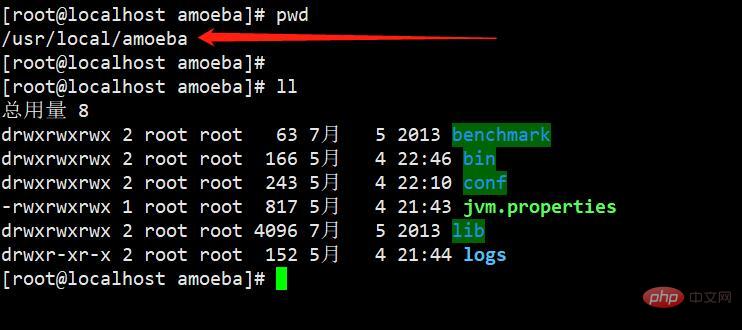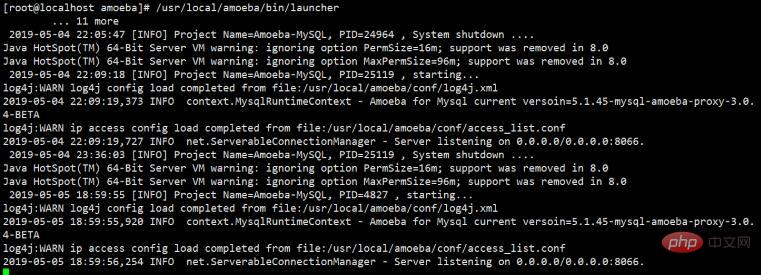How to use amoeba to separate reading and writing of mysql database
There are many read-write separation architectures about mysql. Baidu almost all uses mysql_proxy to implement it. Since the proxy is implemented based on the Lua script language, many netizens on the Internet said that the proxy is not efficient and unstable, and is not recommended for use in a production environment;
amoeba is a project developed by Alibaba that separates database reading and writing (read Write separation is only a small function of it). Since it is written based on java, the running environment needs to install jdk;
Related tutorials: mysql video tutorial
Preliminary preparation Work:
1. Two databases, one master and one slave, master-slave synchronization;
master: 172.22.10.237:3306; The main database is responsible for writing operations;
slave: 10.4.66.58:3306; Slave The library is responsible for reading operations;
amoeba: 172.22.10.237:8066; I installed amoeba on the server where the main library is located. Of course, you can also install it on the third server;
All server operating systems are centos7;
2. Configure and install jdk on the server where amoeba is located;
I installed jdk1.8;
The path is: JAVA_HOME=/usr/local/java/jdk1.8.0_131
Be sure to build and configure the above by yourself. The master and slave work normally. Add the jdk environment variable: /etc/profile;
There are many ways to install amoeba, so I won’t waste any time on the installation here. Download the installation package of amoeba-mysql-3.0.5-RC-distribution and unzip it directly to use;
Unzip directory: /usr/local/amoeba/

Obviously the configuration file is in conf, and the startup program is in bin;
As mentioned just now, amoeba has more functions than reading and writing separation, but if you only use the reading and writing separation function, you only need to configure these files: conf/dbServers.xml conf/amoeba.xml and bin/launcher;
conf/dbServers.xml:
1 2 3 4 5 6 7 8 9 10 11 12 13 14 15 16 17 18 19 20 21 |
|
conf/amoeba.xml:
1 2 3 |
|
launcher is the startup script, if If JAVA_HOME is not configured, even if you configure environment variables in /etc/profile, you may get an error: jdk environment variables are not configured;
There is also a configuration file: jvm.properties
1 2 3 4 |
|
Experienced Everyone in operation and maintenance knows that anything related to jdk is basically related to memory tuning, and amoeba is no exception;
It can be started now:

After startup, you can see the 8066 port of the machine:
At this time, you only need to pass the 8066 port of the machine ip and Just use the account and password set in your configuration file to connect to the database. The data written will go to the master, and the data read will be read from the slave;
Test:
Close the master database and it can still be read. : Execute the select view command;
or
Close the slave database, you can still write: Execute the update and inster commands;
The above is the detailed content of How to use amoeba to separate reading and writing of mysql database. For more information, please follow other related articles on the PHP Chinese website!

Hot AI Tools

Undresser.AI Undress
AI-powered app for creating realistic nude photos

AI Clothes Remover
Online AI tool for removing clothes from photos.

Undress AI Tool
Undress images for free

Clothoff.io
AI clothes remover

Video Face Swap
Swap faces in any video effortlessly with our completely free AI face swap tool!

Hot Article

Hot Tools

Notepad++7.3.1
Easy-to-use and free code editor

SublimeText3 Chinese version
Chinese version, very easy to use

Zend Studio 13.0.1
Powerful PHP integrated development environment

Dreamweaver CS6
Visual web development tools

SublimeText3 Mac version
God-level code editing software (SublimeText3)

Hot Topics
 1393
1393
 52
52
 1205
1205
 24
24
 How to open phpmyadmin
Apr 10, 2025 pm 10:51 PM
How to open phpmyadmin
Apr 10, 2025 pm 10:51 PM
You can open phpMyAdmin through the following steps: 1. Log in to the website control panel; 2. Find and click the phpMyAdmin icon; 3. Enter MySQL credentials; 4. Click "Login".
 MySQL: An Introduction to the World's Most Popular Database
Apr 12, 2025 am 12:18 AM
MySQL: An Introduction to the World's Most Popular Database
Apr 12, 2025 am 12:18 AM
MySQL is an open source relational database management system, mainly used to store and retrieve data quickly and reliably. Its working principle includes client requests, query resolution, execution of queries and return results. Examples of usage include creating tables, inserting and querying data, and advanced features such as JOIN operations. Common errors involve SQL syntax, data types, and permissions, and optimization suggestions include the use of indexes, optimized queries, and partitioning of tables.
 How to use single threaded redis
Apr 10, 2025 pm 07:12 PM
How to use single threaded redis
Apr 10, 2025 pm 07:12 PM
Redis uses a single threaded architecture to provide high performance, simplicity, and consistency. It utilizes I/O multiplexing, event loops, non-blocking I/O, and shared memory to improve concurrency, but with limitations of concurrency limitations, single point of failure, and unsuitable for write-intensive workloads.
 MySQL's Place: Databases and Programming
Apr 13, 2025 am 12:18 AM
MySQL's Place: Databases and Programming
Apr 13, 2025 am 12:18 AM
MySQL's position in databases and programming is very important. It is an open source relational database management system that is widely used in various application scenarios. 1) MySQL provides efficient data storage, organization and retrieval functions, supporting Web, mobile and enterprise-level systems. 2) It uses a client-server architecture, supports multiple storage engines and index optimization. 3) Basic usages include creating tables and inserting data, and advanced usages involve multi-table JOINs and complex queries. 4) Frequently asked questions such as SQL syntax errors and performance issues can be debugged through the EXPLAIN command and slow query log. 5) Performance optimization methods include rational use of indexes, optimized query and use of caches. Best practices include using transactions and PreparedStatemen
 Why Use MySQL? Benefits and Advantages
Apr 12, 2025 am 12:17 AM
Why Use MySQL? Benefits and Advantages
Apr 12, 2025 am 12:17 AM
MySQL is chosen for its performance, reliability, ease of use, and community support. 1.MySQL provides efficient data storage and retrieval functions, supporting multiple data types and advanced query operations. 2. Adopt client-server architecture and multiple storage engines to support transaction and query optimization. 3. Easy to use, supports a variety of operating systems and programming languages. 4. Have strong community support and provide rich resources and solutions.
 How to connect to the database of apache
Apr 13, 2025 pm 01:03 PM
How to connect to the database of apache
Apr 13, 2025 pm 01:03 PM
Apache connects to a database requires the following steps: Install the database driver. Configure the web.xml file to create a connection pool. Create a JDBC data source and specify the connection settings. Use the JDBC API to access the database from Java code, including getting connections, creating statements, binding parameters, executing queries or updates, and processing results.
 How to start mysql by docker
Apr 15, 2025 pm 12:09 PM
How to start mysql by docker
Apr 15, 2025 pm 12:09 PM
The process of starting MySQL in Docker consists of the following steps: Pull the MySQL image to create and start the container, set the root user password, and map the port verification connection Create the database and the user grants all permissions to the database
 Centos install mysql
Apr 14, 2025 pm 08:09 PM
Centos install mysql
Apr 14, 2025 pm 08:09 PM
Installing MySQL on CentOS involves the following steps: Adding the appropriate MySQL yum source. Execute the yum install mysql-server command to install the MySQL server. Use the mysql_secure_installation command to make security settings, such as setting the root user password. Customize the MySQL configuration file as needed. Tune MySQL parameters and optimize databases for performance.





